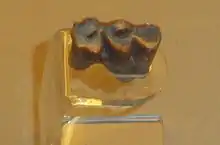| Gazella borbonica Temporal range: | |
|---|---|
 | |
| Fossilized teeth of G. borbonica | |
| Scientific classification | |
| Domain: | Eukaryota |
| Kingdom: | Animalia |
| Phylum: | Chordata |
| Class: | Mammalia |
| Order: | Artiodactyla |
| Family: | Bovidae |
| Subfamily: | Antilopinae |
| Tribe: | Antilopini |
| Genus: | Gazella |
| Species: | †G. borbonica |
| Binomial name | |
| †Gazella borbonica Depéret, 1884 | |
| Synonyms[1] | |
| |
Gazella borbonica, commonly known as the Bourbon gazelle or European gazelle, is an extinct gazelle which existed in Europe during the Pleistocene epoch.[2] It was described by Charles Depéret in 1884.[3]
It had rather long, moderately divergent and slightly recurved horns and was about the same size as the modern Dorcas Gazelle, with a shoulder height of about 60 cm.[2]
Fossil remains have been found in France, the Netherlands and south-east England.[2] Taxonomic synonyms include Gazella anglica Newton, 1884 and Gazella daviesii Hinton, 1906.[1]
References
- 1 2 BioLib
- 1 2 3 Kurtén, Björn (1968). Pleistocene mammals of Europe. New Brunswick, N.J.: AldineTransaction. pp. 171–172. ISBN 9780202309538.
- ↑ Petronio, Carmelo; Bellucci, Luca; Martiinetto, Edoardo; Pandolfi, Luca; Salari, Leonardo (2011). "Biochronology and palaeoenvironmental changes from the Middle Pliocene to the Late Pleistocene in Central Italy". Geodiversitas. 33 (3): 485–517. doi:10.5252/g2011n3a4. hdl:2318/128607. S2CID 131503285.
This article is issued from Wikipedia. The text is licensed under Creative Commons - Attribution - Sharealike. Additional terms may apply for the media files.